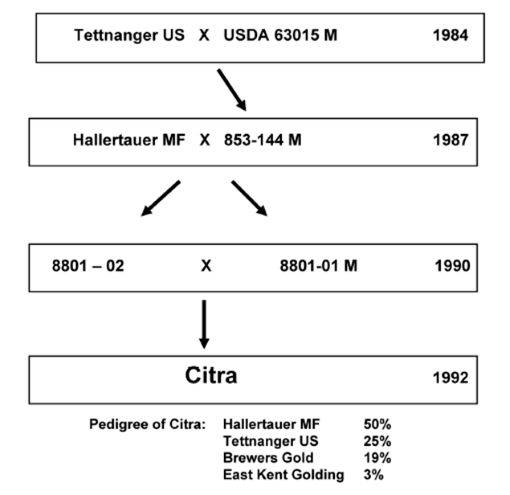From Vol. 4, No. 6, October 2020
It took Citra so long to get to market that it had two difference experimental names, X-114 and HBC-394. A dozen year later, growers (in this case, located only in the American Northwest) harvest more tons of Citra than any other aroma variety in the world.
She cast an even longer shadow. Citra was central to Japanese research – resulting in a paper titled, “The Contribution of Geraniol Metabolism to the Citrus Flavour of Beer” in 2010 – that introduced many brewers to biotransformations. And it was at the 2008 Craft Brewers Conference that Tom Nielsen of Sierra Nevada alerted them that a thiol compound, 4-mercapto-4-methylpentan-2-one (4MMP), in Citra was contributing to new, exotic aromas.


Heritage. Citra is more continental (7/8ths, in fact) than American. Her mother is Hallertau Mittelfrüh. Looking at her lineage, remember that US Tettnanger is really Fuggle. However, she is 19% Brewer’s Gold, which was a daughter of BB1, a wild American hop collected in Manitoba.
Gene Probasco at John I. Haas, who since has retired, made the crosses as part of a project for a brewery client, one that lasted three years and created 150 potential cultivars. The brewery produced single-hop beers with each of them, and Probasco tasted them all. The one brewed with a hop called X-114 stood out. “I recognized that as something special,” he said.
Nothing resulted from that project, but a few years later another large brewer contracted with Haas to develop a hop with unique aroma. Along with new crosses, Probasco gave them X-114. They brewed a test batch. “It tasted exactly like it did the first time,” he said. Again, nothing resulted, but he kept the hop alive on a seven-hill plot he calls the museum. “I never forgot about that flavor.”
Sometime after 2000 he was traveling with Pat Ting, then a hop chemist at Miller Brewing.
“I need a citrus variety,” Ting said.
“I have one,” Probasco replied.
The next year he shipped a two-pound sample to Miller Brewing. Miller provided the financial support for the first commercial production of Citra. “They tested it for quite a few years,” Probasco said. Miller basically owned the hop for two years. Troy Rysewyk at Miller’s pilot brewery brewed a batch called Wild Ting IPA, dry hopping it with only Citra, in the pilot brewery. “It smelled like grapefruit, lychee, mango,” Ting said.
“But fermented, it tasted like Sauvignon Blanc.”
In 2002, Haas and Select Botanicals Group merged their breeding programs to form the Hop Breeding Company. HBC began sending breweries samples, including small cuts of X-114. Eventually Widmer Brothers Brewing and Deschutes Brewery in Oregon, and Sierra Nevada Brewing in California, financed more acreage.
In 2008, Widmer Brothers Brewing won a gold medal in the World Beer Cup with an American-style pale ale hopped with Citra and called X-114. Eighteen years after her parents were cross-pollinated, Citra was an overnight sensation.
The basics: 11-13% alpha acids, 3.5-4.5% beta acids, 2.2-2.8 mL/100 grams total oil. Noted for its free thiols, particularly 4MMP (also known as 4MSP).
Aroma qualities: Citra has become so well known that I feel a bit silly tossing out descriptors. As the name implies, citrus-heavy, lime and grapefruit, passion fruit and lychee. Tropical.